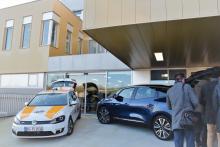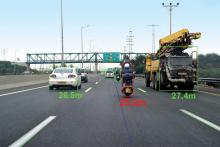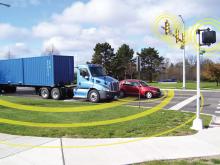
Data handling is becoming an ever-greater part of transportation and never more so than with autonomous vehicles, as Andrew Bardin Williams hears from some big names.
Autonomous vehicles are coming. Semi-autonomous cars are available today with features such as lane-assist, parallel parking and brake assistance while fully-autonomous vehicles are being tested on roadways in California, Missouri, Michigan, Virginia and other states. Michigan will vote in the next few months on a bill that would allow fullyautonomous vehicles on public roadways without requiring a passenger to sit in the driver’s seat on standby. It’s advances like this that have led BI Intelligence to estimate that, globally, there will be more than 10 million self-driving cars by 2020.
However, it is not all smooth sailing. The first recorded fatality in a crash involving an autonomous vehicle occurred in Florida in June and vocal opponents proclaim they will never fully give up control of their vehicle to a machine—citing concerns about safety, security, choice and a loss of freedom.
These issues haven’t gone unnoticed by vehicle makers, ITS suppliers, transportation authorities or legislatures. In a world where smartphones occasionally crash, malware continues to infect personal computers and payment card information is vulnerable to hacking, both authorities and the public need to feel completely confident in turning over control of vehicles to autonomous software.
Shuttle solution
Olli is a shared-use vehicle, likely to be deployed as a shuttle in large parking lots at airports, amusement parks or museums and on campuses. According to Matt Lesh, director of mobility systems for Local Motors, the developers are looking at Olli to bridge the first and last mile gap, connecting commuters to other transportation options at both starting point and destination.
What is needed for Autonomous vehicles to succeed?
"We need policies around the data we are collecting, and [we need to] figure out how to implement these policies. We need consistent messaging from the federal, state and local levels of government on how to interpret and classify data"
Matt Lesh
Local Motors
"We need to figure out how to take current roadside systems and bring disparate data together. Both the quality and quantity of data need to be there. We need to provide standard data that can be easily connected to data analytics back-ends"
Joe Averkamp
Xerox
"We need greater context of the world around us. How can we analyse external data with humanmachine interaction? We need to facilitate naturalsounding dialogue between the person and the machine"
Bret Greenstein
IBM
When moving, autonomous vehicles need to collect and process massive amounts of information every second. Sensors inside the vehicle analyse road and weather conditions and make adjustments accordingly while detecting and communicating with other vehicles, pedestrians and obstacles in the roadway. They’re also monitoring and self-diagnosing the mechanical mechanisms while sharing information with other vehicles, infrastructure and potentially a control centre that could manage the transportation network holistically. On top of that, autonomous vehicles need to interface with passengers regarding route preferences, climate control, entertainment and so on.
“Data is absolutely key to making Olli work well in the real world,” Lesh said. “We’re creating a new transportation ecosystem that combines mobile technology and IoT (Internet of Things) and connects us to the world through our mobile devices.”
“Big Data is a treasure chest of information that optimises routing and helps alleviate issues based on information we learn throughthe collection and evaluation of data,” Lesh said. “This allows us to have an intuitive, convenient one-on-one interface between Olli and passengers, get [to destinations] quicker but save energy and possibly stop at a passenger’s favourite coffee shop along the way.”
Local Motors is working with IBM to better manage and analyse the mountains of data Olli needs on a second-by-second basis.
Specifically, Olli leverages machine learning, the Watson supercomputer and IBM’s expertise in the IoT.
According to Bret Greenstein, vice president of IBM Watson and the IoT Group for IBM, most data vehicles collect is valuable for only a millisecond, and autonomous driving systems need to clear through the noise and know what can be turned into actionable information. IBM does this by maintaining a last data cache that only keeps the most recent information while letting extraneous or outdated information (if only by a few milliseconds) float into the ether.
That data is then analysed to detect outliers and changes to known information through simple algorithms or rules. Paring down the mountains of data flowing in to, out of and around an autonomous vehicle to just the pertinent information enables the speed necessary to provide the real-time insights.
That speed that allows the vehicle to swerve in time to miss a pedestrian in the roadway, slow down while approaching a curve or reroute around lane closures or roadworks. IBM also analyses unstructured data such as video streams and audible commands from Olli’s passengers. According to Greenstein, IBM Watson uses machine learning to better understand the preferences of passengers to deliver a safer, more convenient ride.
That’s why technology companies like IBM and
“Simply put, vehicles have to perform flawlessly,” said Joe Averkamp, senior director of technology, policy and technical strategy for Xerox.
According to Averkamp, Xerox is working with dozens of vehicle manufacturers, transportation authorities and cities to manage the back office side of autonomous vehicles—specifically what Averkamp calls transactional processing, information systems and security of information layers.
In terms of transaction processing,transportation agencies will need to figure out how to deal with autonomous vehicles on toll roads, in high occupancy lanes and in parking spaces. Can an autonomous vehicle travel in high-occupancy vehicle (HOV) lanes? Can it idle in a passenger loading zone? Does an unoccupied vehicle need to pay a toll? These are the questions that Xerox is helping transportation agencies figure out from a policy standpoint as well as a technology standpoint.
How do you detect autonomous vehicles?
How do you count passengers when there is no driver? All these things are determined by how well an agency can collect, manage and analyse information in real time.
More obvious is Xerox’s informational systems services where autonomous vehicle manufacturers need to figure out how to detect changes in road conditions, read signs, communicate with road infrastructure and other vehicles and compile the most efficient routes based on passenger preferences. Specifically, Averkamp worries about how autonomous vehicles will detect work zones or closed lanes due to events or detect an upcoming curve and slow down before going into a turn in slippery conditions. How will signals be detected and timed appropriately? Visual systems can tell the difference between red and green signals, but couldn’t advance warning streamline traffic flow much better? How such data is created, broadcast, shared, stored and analysed needs to be standardised to National Highway Traffic Safety Administration requirements and made available to vehicle manufacturers over dedicated short range communication (DSRC) channels.
The step forward
It’s clear that there are two ways of thinking about how to bring about autonomous vehicles. Some, like Google, Tesla and major car makers, want to transform existing vehicles and optimise them for autonomous driving. Others, like Local Motors, want to utilise fresh technology and the power of Big Data to drastically improve the way we travel around cities—whether that means a car in every garage or not. Either way, the ability for autonomous vehicles to collect, secure, manage and analyse the mountains of information flowing through urban transportation systems will go a long way in making autonomous vehicles acceptable to all consumers.









